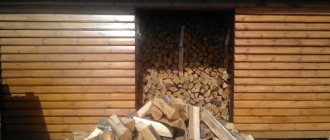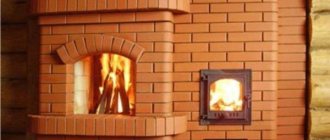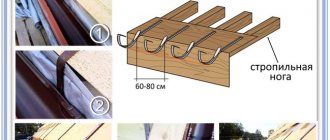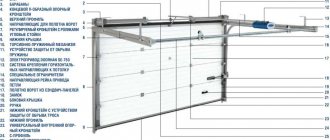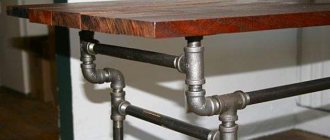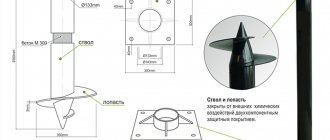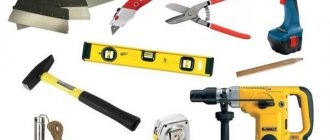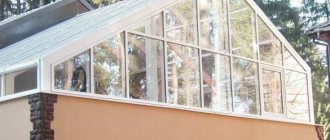Cage
This method of laying is suitable for long, even firewood: each top layer of logs must be laid perpendicular to the bottom, that is, crosswise. Experts believe that fuel is stored longer this way due to good air circulation.
The photo shows firewood stacked in a cage. Slate and pallets serve as pallets. The wood in the woodpile dries well, as it is located on the sunny side.
The method of laying firewood in a cage is suitable for constructing woodpiles of “wells”, which serve as reliable supports. Firewood stacked on top of each other (that is, in parallel) is unstable, and the destruction of the woodpile threatens damage to the material and wasted effort. Cross-shaped wells on the sides or inside the stacks give them stability.
How to make a foundation correctly
At the initial stage, you need to lay out the ring and leave the central part empty. The result is a connected chain, the logs of which touch at the ends. The next layer is laid across the first, the slope is naturally oriented towards the middle. On the second layer, contact occurs with the side parts of the log, and not with the ends.
The center is free, gradually a pipe is formed in place of the center, which ensures the passage of air and rapid drying of the firewood. The rows may lose slope because the thickness of the logs varies. In this case, supports are installed along the edges, running across them - a ring that supports the edges of the first row. This will make the structure reliable and stable.
By the Wall
Without a separate firewood rack, many owners of village and country houses prefer to store fuel near the wall. This method is convenient because one side has a strong support, and the rest are open for ventilation. The walls of a house or barn are often used as a base. A small woodpile can also be placed near the bathhouse in order to have fuel reserves nearby.
The photo shows a wall-mounted woodpile located under the stairs. Thanks to this solution, the firewood is protected, and the space is used as rationally as possible.
Before stacking firewood in a wall woodpile, we advise you to insulate it in any suitable way: insulation will protect the wall from insects and rodents that can move into a house made of wood material.
Stacking firewood
How to stack a woodpile so that the firewood does not “scatter” throughout the yard? The rules are simple:
- It is desirable that the firewood be uniform in length and thickness. They should be stacked close to each other.
- Do not erect a structure higher than 2 m - it is inconvenient for getting firewood and is unstable. Optimally - no higher than 1.5 m.
- Form the bottom “floor” from the smoothest and longest logs.
- Don't overcrowd the woodpile. The overweight contributes to the deformation of the entire structure.
Near the fence
In a similar way, you can put firewood in a woodpile not far from the fence. In this case, the owner of the fence must himself determine the degree of benefit of this option and the possible risks. If the fence is unstable, a high woodpile can break the structure.
The firewood will be dry if you leave a few centimeters between it and the fence. The same rule should be followed if you need to fold the woodpile in two rows. For stability, it is worth using strong stakes on the sides, and if it was not possible to prepare them, stacking the firewood in a cage will help.
The photo shows a fence with built-in niches for firewood. The woodpile not only forms part of the fence, but also adds a decorative touch to the design.
Assembling an open woodpile
Particularly difficult is the installation of this type of woodpile, since it will not hold onto anything, because open structures are usually built without support for anything. But their advantage is that they can be placed anywhere, and the firewood in them will dry much faster than in other types where the walls are closed.
Storing firewood without a frame Source stoydiz.ru
Round
The firewood rack in the form of a circle adds sophistication to the site and fits harmoniously into any landscape design. The structure can be solid or divided by shelves on which firewood, chips and cuttings of boards are stacked. The round woodpile is well protected from moisture by its shape.
In addition to finished products, summer residents often use homemade firewood burners from metal 200-liter barrels, sawing them into three parts, painting them and placing fuel in them. The lightweight structure can be mounted on the wall, making a compact mini-woodshed: in a small area this is an excellent solution that will save space.
In the photo, a hanging firewood burner for small scraps, made by yourself.
Additional Information
If you plan to build a lightweight firewood shed with a capacity of only a few cubic meters, a pile foundation is not needed for it. It is enough to place concrete pillars, old curbs, and several bricks under each support point under the base; It is possible to install a pile, columnar foundation made of brick. If desired, a shallow or shallow strip foundation can be poured. Concrete piles in roofing felt can be replaced with asbestos-cement pipes, pouring a concrete mixture with polyethylene waterproofing, or even into natural formwork; On the basis of any completed foundation, you can build a firewood shed from a steel pipe or angle. If a strip foundation is made, the foundations of the walls can be made of blocks or bricks; To improve ventilation of the lower part of the firewood storage structure, the lower rows are laid with increased clearance; To avoid stagnation of water under the woodpile, drainage can be made under it
When laying the foundation part, soil is excavated inside the perimeter to a depth of 20-30 cm, into which crushed stone or broken brick is poured; The front part of the structure can be additionally covered with a curtain made of polyethylene, tarpaulin, or banner fabric; To extend the service life of the frame and lining of the woodshed, all materials are treated: wood - with drying oil and varnish, or antiseptic-based paint, PF paint; steel frame - anti-corrosion coatings for metal, powder paint, ordinary enamel; It is important to carry out the correct turnover of firewood inside the storage warehouse so that the back stacks do not lie untouched for years while the nearby rows are consumed and renewed with new harvested firewood. Once every 3-4 years you need to disassemble the warehouse, check it, sort it out and put it back together again
This will help remove rotten, spoiled logs from the firewood storage area!
Construction of a medium-sized firewood shed in a country house, provided the materials and necessary tools are available, takes up to two days, not taking into account the technological periods associated with the foundation. But this time will be well spent, because now you can light up the stove or grill at any time using dry and fresh firewood, rather than smoking and non-flammable wet wood!
How to stack firewood? The simplest option is to place the pipes in stacks. Butt the logs end to end, forming a layer-by-layer structure. Separate walls of firewood should be in contact with their ends
It is important that adjacent structures have some slope towards the inside. Do not let the walls lean outward
As the height of the raspberries increases, the distortion will noticeably increase during laying. The walls will certainly begin to crumble to the sides where there is no support.
Little house
The round woodpile in the form of a stack has another subspecies - a house. It is distinguished by vertical walls, laid in the same pattern as in the previous paragraph, and a conical roof on top.
To ensure reliable storage of fuel, it is important to stack the firewood correctly, that is, with an overlap. The roof, like a canopy, should protect from precipitation. For beginners, it is better to start with low buildings.
What to create a frame from
In order for the firewood to “lie quietly”, the woodpile needs a frame. It is usually made of metal or, much more often, wood. Both materials have advantages.
Photo gallery
The listed methods of stacking firewood differ in the amount of material used, placement, and labor costs. Today, woodshedders have another interesting function - decorative. They have interesting architectural forms, laid out in the form of a spiral, balls, animals, paintings and outbuildings.
To build such compositions, you need to have a lot of experience, since decorative stacking of firewood in a woodpile requires patience and artistic taste. You can see unusual woodpile options in our photo gallery.
Video: tips for laying an oval woodpile for quality firewood storage
There are several more options for stacking firewood that will ensure their safety and quality. Different regions of Russia and other countries have developed their own traditions of coping with this task, and the secrets of this unique art are passed on from generation to generation. In the surrounding areas you can see beautiful houses and mushrooms, walls and pyramids, or even beautiful multi-colored paintings - all this looks like a separate branch of applied folk art. If you want to create one of these woodpiles, you should use your imagination, learn the rules for stacking firewood and show remarkable patience - then everything should definitely work out.
Which wood species should be preferred?
If you approach provision in a businesslike manner, you will begin collecting firewood in the period from November to February. This is the optimal time to purchase wood. In addition, the winter forest has minimal natural humidity. Such wood dries outside to acceptable humidity within six months. Over time, procurement was determined. Now you need to understand what exactly you should buy. To answer this question, you need to keep in mind what the firewood will be used for. Each type of wood has its own advantages and disadvantages, different heat capacity, burning rate and degree of heat transfer (this is affected by their humidity and density). The higher the latter, the longer the log burns and gives off more heat. The most commonly sold firewood is made from the following wood species:
- conifers (spruce, pine, larch);
- deciduous (alder, aspen, birch) species.
Needles
Coniferous firewood creates intense heat during the combustion process, but burns out quite quickly. In addition, these logs contain a high content of resins, which, during the combustion process, emit a light, pleasant aroma. Spruce and pine chocks have a beneficial effect on the human immune system and tone the respiratory system. Pine burns with a hotter flame. The spruce periodically “shoots” sparks and pieces of coal. This is the best choice for barbecue, grill or barbecue. But they can be used to light stoves and fireplaces only after thorough drying. The firewood used for this must have a humidity of ≤20%. Wood with a high index smokes heavily and releases resin. The latter settles on the internal surfaces of chimneys. Which reduces their flow area and worsens traction.
Birch
This material is optimal for any purpose due to its qualities. Birch logs:
- easy to light;
- characterized by abundant heat generation;
- duration of combustion;
- beautiful game of open fire;
- reasonable price;
- do not spark or “lose” embers;
- The aroma released during the combustion process has a healing effect on the condition of the human body.
The disadvantages include the high content of tar, which is released during the combustion process. It adversely affects health and settles in chimney pipes, reducing the draft of the heating device.
Alder
This firewood rightfully has the status of “royal”. They flare up quickly, burn for a long time and stably with significant heat release. The process is virtually smokeless. Combustion is accompanied by a pleasant aromatization of the air in the immediate vicinity of the fire. It is alder that people tend to use for smoking lard, meat and fish.
Oak
Together with the two above-mentioned species, it is one of the three best lumber. Due to its high density, it has a maximum burning time and high heat. The tart aroma is good for health. The only drawback of this wood is the high price.
Linden
Very slow and difficult to light. But after that it burns with a significant release of heat. Honey aroma treats colds.
Aspen
Difficult to light, burn out quickly. The only advantage is that they don’t smoke. Moreover, they are able to remove existing carbon deposits from the surface of the stove and chimneys. They are used primarily for this purpose (their calorific value is minimal).
Types of firewood
It will take very little time to make your own woodpile. The design is elementary. By looking at the photo of the woodpile, you can once again be convinced of this.
A lot of attention should be paid to aesthetics, otherwise an important component – the decorative function – will be lost. You can rely on your strength, imagination, available materials, and start creating a drawing. Or you can take a closer look at those options that you definitely can’t do on your own.
The design will be light. Even a large metal woodpile will look great on a summer cottage with a small area.
Why is it necessary to arrange a place where you plan to store fuel for stoves, fireplaces, baths?
It is difficult to imagine a private house or summer cottage where firewood is not used. They are needed for the fireplace, sauna, shish kebabs, barbecue. Or just for evening gatherings with a guitar by the fire. Therefore, the issues of correct selection, preparation, and storage of firewood are very interesting to many people. This article provides answers to them. This question can be considered rhetorical. But it sometimes occurs among some careless owners who consider such work to be a waste of time. This opinion is wrong. Let's figure out why.
- First of all, due to waterlogging. Atmospheric precipitation and humidity inherent in the soil initiate the emergence of pathogenic microflora.
Firewood becomes affected by mold and mildew, begins to rot, and turns into dust. Such “fuel” kills the fire. Your stove (hearth, fireplace, fire) begins to smoke mercilessly. It is impossible to properly heat the house, cook food on the barbecue, grill or stove in such a situation.
- For advanced summer residents and owners of private residential buildings, we note that the calorific value of such logs decreases.
Let's remember the basics of physics. When wood burns, a certain amount of heat is released, the value of which directly depends on the type of wood and the degree of humidity. The more moisture, the lower the calorific value. A significant part of the heat is spent on the evaporation of moisture, along with which a lot of thermal energy is lost. Accordingly, efficiency decreases, and the price of heating a house rapidly increases. As well as the consumption of firewood required for cooking food over an open fire.
- The third reason is an aesthetic issue.
The appearance of a garden (dacha) plot deteriorates significantly when several different-sized piles of sawn and chopped logs appear on the street, mixed with garden trimmings. In order not to spoil the carefully formed landscape design, it is highly advisable to choose the right place to store firewood on the site and create the required conditions for this.
Dome option
How to stack firewood in a woodshed using the dome method?
To make the woodpile acquire the peculiar shape of a haystack, fold the chibouks into a hemisphere. The formation will be truly compact and stable. Clear the soil to bare ground and draw a regular circle several meters in diameter. Fill the space of the figure with shanks end to end, leaving minor gaps. Place a stable pole in the center. Leave a little free space around such a rod to achieve high-quality ventilation inside the structure.
Continue stacking the wood in a circle with the ends facing toward the center of the ring. Form several layers. Leave the inside area near the pole empty. Alternatively, loosely sprinkle small wood chips into the space created. Closer to the top, move the ring of chibouks inward. To tilt the logs in the desired direction, periodically place thin planks between the layers.
The method of storing wood fuel will be effective and in demand only when the firewood is dry and well ventilated during storage. That is why the lower edge of the future woodpile should always be located not ON the surface of the earth, but ABOVE the surface, that is, on a kind of pallet or in a place inaccessible to moisture penetration. Otherwise, after the bottom row of firewood, the top rows will also rot.
That is why unique columns are laid out on the sides of the future woodpile, reinforcing the overall structure. With each subsequent row, the logs in these columns are laid across the previous row, which gives the entire structure stability and allows, along with chopped logs, to store unchopped round timber.
There are three most common types of stacking logs in a woodpile. In particular they are:
- stacking firewood, where firewood is stacked row by row on top of each other in parallel;
- laying firewood in the manner of a cage, where each subsequent row, as in the case of the side columns described earlier, lies perpendicular to the previous one;
- stacking firewood using the circular method, where firewood is stacked in a kind of circular stack.
Often, stacking is a shaky structure, and therefore this method is good if there is a supporting wall. It can be the wall of a barn or any other outbuilding.
In the process of stacking logs in a stack parallel to each other, you should pay attention to the fact that the growing woodpile constantly tilts towards the supporting wall. The slope is created by placing the thicker edge of the logs on the outside
If the woodpile runs steadily and levelly without any slope, the structure can be given a tilt by placing thin slats between the rows on the outside.
The following photo shows an example of a free-standing woodpile, where the sides are protected from spillage by a kind of frame made of boards.
This is what it looks like initially. The lower part protects the firewood from contact with damp ground, and the side parts prevent the woodpile from spilling.
Wood crates are many times more stable than stacks, however, even a free-standing wood crate is not immune to tilting and subsequent disintegration. As already mentioned, a cage is often used to strengthen a stacked woodpile against spillage, and by approaching the process of folding the woodpile creatively, one can “blind” a real “Portrait of the Artist’s Wife.”
Also worthy of attention is a circular woodpile in the shape of a kind of tent, thickened towards the top. But it is worth remembering that creating such structures can take much more time and patience.
Some particularly advanced masters even give their masterpieces the appearance of original residential buildings, decorating them with doors into which a drunken, lost neighbor might begin to break, and window frames in which he might try to break the glass.
Closed structures made like huts are also ideal for storing firewood. Here the fuel will be the driest and always ready to ignite.
And after a long and meticulous laying of such a woodpile, which is a real work of wood art in the form of a fallen tree with unfallen golden leaves, the unlucky and patient wood sculptor and dreamer will seriously think about preparing more firewood for heating and putting it in a separate inconspicuous woodpile , which you won’t mind disassembling later for firewood.
Along with “Portraits of the Artist’s Wife,” some manage to create self-portraits.
Some lover of ancient old Russian wooden architecture decided to create woodpiles, like no other, more suitable in geometric slope to the domed church located in the background.
The more convenient it is to carry logs
Carrying logs in your hands is uncomfortable. Especially if they are wet, dirty or covered in ice and snow. The “third” and “fourth” steel hand comes to the rescue - a pincer (grab) grip.
152247User FORUMHOUSE
I was wondering if anyone has used a manual log gripper? Is it worth paying 3,000 rubles for a branded one? I want to order some for myself so I can load the logs. Is it convenient to use?
Russlanych FORUMHOUSE user
I've been using a pincer gripper for 5 years. I have never regretted buying it. I took them for 1500 rubles. My friends told me that he threw away the money, but now I don’t go to the forest for firewood without it.
When purchasing grab pliers, keep in mind that there are models with different grip widths. For example, under logs with a diameter of 20 and 30 cm. With pliers with a large grip, you can grab both large and small logs.
By the way, there is a cheaper option - single-jointed log pliers. Is it worth taking them?
wind1windSuper-Moderator FORUMHOUSE
With a single-joint grip, to prevent the log from slipping out, you will have to squeeze the handles, i.e. make additional physical efforts. On soft wood the force is less, on hard or frozen wood more. In double-jointed grips, compression occurs automatically due to the weight of the lifted log.
Well, for all home-made people, a user with the nickname 152247 offers to make a hand made version of branded pliers with a grip width for a log with a diameter of 30 cm.
In the background is a piece of paper with a 5x5 mm square.
Summary
Try to prepare the firewood in advance to allow it to dry thoroughly. For this you will need:
- 5-6 months during winter harvesting;
- 10 months when harvesting in summer.
The type of wood also plays a role: birch and aspen dry the fastest. They burn well and for a long time, although the heat transfer is lower than that of conifers. Pine and spruce have high heat transfer, but they emit a lot of soot, which is why chimneys need to be constantly cleaned.
Appearance of firewood from: birch, pine and oak
Oak is considered an elite fuel - although it dries up to 8 months, the heat transfer is the highest. Like coniferous and fruit trees, its wood emits pleasant aromas when burned.
Did you find useful information in our article?
Street firewood
Making an outdoor firewood rack yourself is not difficult. It can be made of metal or wood. You can use available materials: old barrels, rings from a well, sheets of metal. Requirements for a woodcutter:
- the firewood must be well protected from precipitation, otherwise the structure loses its meaning, the roof should not flow;
- should be easy to use so that collecting the next portion of fuel each time does not turn into a quest;
- good ventilation must be ensured - this is the main difference from a closed barn, otherwise the logs will become damp and rot;
- It is desirable that the construction be done carefully and decorate the site.
Depending on the amount of fuel stored in winter, the firewood shed can be a small structure for one woodpile or a full-fledged, spacious shed. To create the necessary conditions for proper storage of firewood, you need to take into account a number of rules:
- You cannot stack the woodpile directly on the ground; it is better to build a floor by raising it 15 cm from the ground, otherwise the lower layer of firewood will become damp;
- walls must have openings for good air circulation;
- the roof of the building must be sloped so that precipitation does not linger and form condensation;
- If you need to store a large amount of firewood, you need to equip a reliable foundation that can withstand the weight of the firewood.
For a small supply of firewood, you can build a frame from bars, covering it with a roof. Any roofing material can be used for the roof: corrugated sheeting, metal tiles and even polycarbonate. The floor can be laid from pallets.
Using wood has its advantages:
- treated wood will last quite a long time;
- easy to cut to size;
- wooden structures are quickly assembled and disassembled;
- low price;
- Due to the lightness of the material, there is no need to make a foundation for a wooden structure; brick can be used to arrange the base.
The frame can also be welded from metal corners. They should be treated with a rust preventative.
Advantages of a metal frame:
- long service life;
- reliability of the structure with proper fastening of the elements;
- resistance to fire and adverse environmental factors, the main thing is to protect against rust.
Canopy
A firewood shed for a dacha can be more substantial - in the form of an outbuilding under a canopy. It is not difficult for a home craftsman to do it himself. We will need:
- beam,
- boards,
- nails or screws,
- hammer or screwdriver,
- roofing material,
- some concrete.
We mark the contours of the future structure on the ground according to the given dimensions. We make a columnar foundation for the pillars of the structure. When the concrete gains strength, we lay timber along the contour.
We set up the racks and attach them to the horizontal beams. We secure the structure with an upper belt made of timber. The frame is ready.
We install the floors above ground level, resting the logs on the lower horizontal beams. Lay waterproofing material on the boards. This may be a layer of roofing material.
We cover the walls with boards, leaving gaps between them for air access. We place the boards vertically or horizontally depending on aesthetic preferences.
Small cross-section bars nailed at an angle crosswise look beautiful. The wooden lattice imitates a flower trellis and fits organically into the overall design of the site.
Now let's start installing the roof. We install transverse rafters and sheathing on the upper belt of timber. We arrange a single-pitched roof with a slope towards the rear wall.
Alternatively, hang a couple of hinges and a door on the woodshed.
